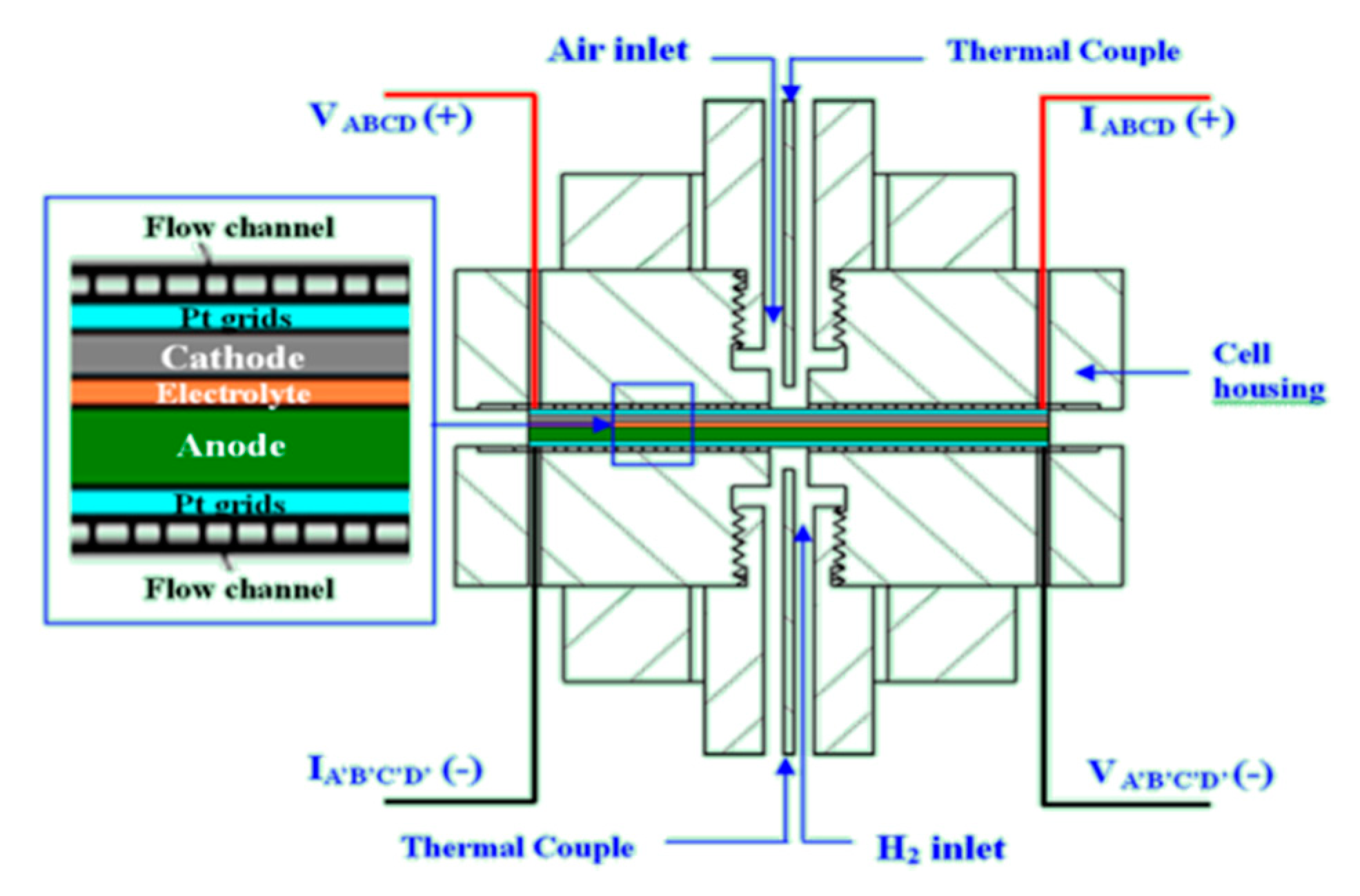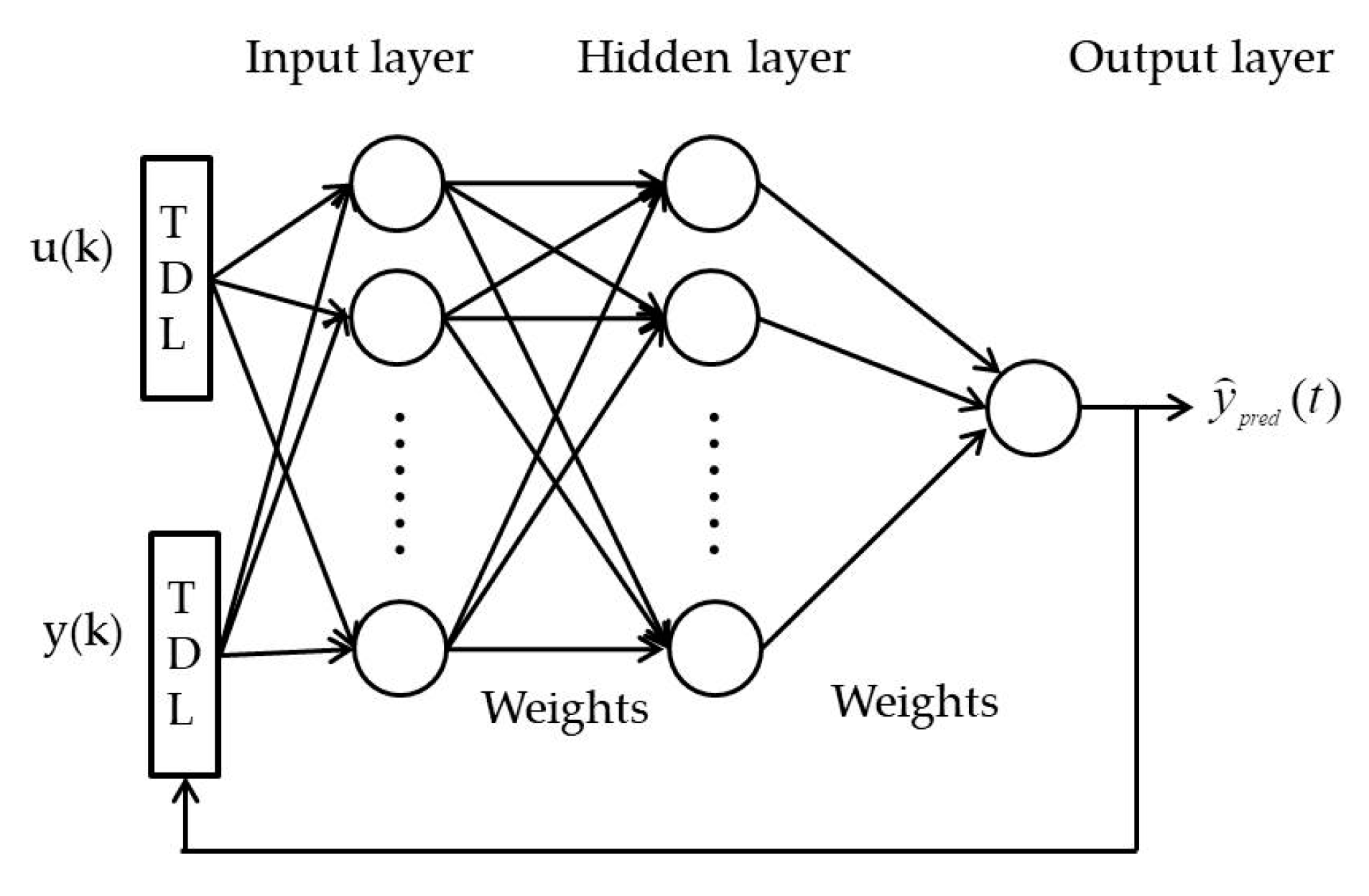Performance Prediction Model of Solid Oxide Fuel Cell System Based on Neural Network Autoregressive with External Input Method
Abstract
1. Introduction
2. Materials and Methods
2.1. Data Description and Test System
2.2. Applied Methodology
2.2.1. NNARX Model
2.2.2. Taguchi OA Method
2.2.3. Model Validation Criteria Metric Definitions
2.2.4. Multi-Step Ahead Prediction
3. Results and Discussion
3.1. Analysis of the Selected NNARX Model Structure
3.2. Comparison and Prediction Analysis
4. Conclusions
Author Contributions
Funding
Acknowledgments
Conflicts of Interest
References
- Stambouli, A.B.; Traversa, E. Solid oxide fuel cells (SOFCs): A review of an environmentally clean and efficient source of energy. Renew. Sustain. Energy Rev. 2002, 6, 433–455. [Google Scholar] [CrossRef]
- E4tech. The Fuel Cell Industry Review 2017; E4tech: London, UK, 2017; Available online: http://www.fuelcellindustryreview.com (accessed on 20 January 2020).
- Kaur, G. Solid Oxide Fuel Cell Components: Interfacial Compatibility of SOFC Glass Seals; Springer: Berlin/Heidelberg, Germany, 2016. [Google Scholar]
- Ma, R.; Gao, F.; Breaz, E.; Huangfu, Y.; Briois, P. Multidimensional Reversible Solid Oxide Fuel Cell Modeling for Embedded Applications. IEEE Trans. Energy Convers. 2018, 33, 692–701. [Google Scholar] [CrossRef]
- Wang, K.; Hissel, D.; Péra, M.C.; Steiner, N.; Marra, D.; Sorrentino, M.; Pianese, C.; Monteverde, M.; Cardone, P.; Saarinen, J. A Review on solid oxide fuel cell models. Int. J. Hydrog. Energy 2011, 36, 7212–7228. [Google Scholar] [CrossRef]
- Gebregergis, A.; Pillay, P.; Bhattacharyya, D.; Rengaswemy, R. Solid oxide fuel cell modeling. IEEE Trans. Ind. Electron. 2009, 56, 139–148. [Google Scholar] [CrossRef]
- Klotz, A.D.; Leonide, A.; Weber, A.; Ivers-Tiffée, E. Electrochemical model for SOFC and SOEC mode predicting performance and efficiency. Int. J. Hydrog. Energy 2014, 39, 20844–20849. [Google Scholar] [CrossRef]
- Hajimolana, S.A.; Hussain, M.A.; Daud, W.M.A.W.; Soroush, M.; Shamiri, A. Mathematical modeling of solid oxide fuel cells: A review. Renew. Sustain. Energy Rev. 2011, 15, 1893–1917. [Google Scholar] [CrossRef]
- Stempien, J.P.; Liu, Q.; Ni, M.; Sun, Q.; Chan, S.H. Physical principles for the calculation of equilibrium potential for co-electrolysis of steam and carbon dioxide in a Solid Oxide Electrolyzer Cell (SOEC). Electrochim. Acta 2014, 147, 490–497. [Google Scholar] [CrossRef]
- Wang, C.; Nehrir, M.H. A physically based dynamic model for solid oxide fuel cells. IEEE Trans. Energy Convers. 2007, 22, 887–897. [Google Scholar] [CrossRef]
- Andersson, M.; Yuan, J.; Sundén, B. Review on modeling development for multiscale chemical reactions coupled transport phenomena in solid oxide fuel cell. Appl. Energy 2010, 87, 1461–1476. [Google Scholar] [CrossRef]
- Peksen, M. A coupled 3D thermofluid–thermomechanical analysis of a planar type production scale SOFC stack. Int. J. Hydrog. Energy 2011, 36, 11914–11928. [Google Scholar] [CrossRef]
- Rossia, I.; Traversoa, A.; Tucker, D. SOFC/Gas Turbine Hybrid System: A simplified framework for dynamic simulation. Appl. Energy 2019, 238, 1543–1550. [Google Scholar] [CrossRef]
- Huang, Q.A.; Hui, R.; Wang, B.; Zhang, J. A review of AC impedance modeling and validation in SOFC diagnosis. Electrochim. Acta 2007, 52, 8144–8164. [Google Scholar] [CrossRef]
- Zhongliang, L.; Rachid, O.; Daniel, H.; Stefan, G. Data-driven diagnosis of PEM fuel cell: A comparative study. Control Eng. Pract. 2014, 28, 1–12. [Google Scholar]
- Wu, Y.; Breaz, E.; Gao, F.; Miraoui, A. A Modified Relevance Vector Machine for PEM Fuel-Cell Stack Aging Prediction. IEEE Trans. Ind. Appl. 2016, 52, 2573–2581. [Google Scholar] [CrossRef]
- Ogaji, S.O.T.; Singh, R.; Pilidis, P.; Diacakis, M. Modelling fuel cell performance using artificial intelligence. J. Power Sources 2006, 154, 192–197. [Google Scholar] [CrossRef]
- Puranik, S.V.; Keyhani, A.; Khorrami, F. Neural Network Modeling of Proton Exchange Membrane Fuel Cell. IEEE Trans. Energy Convers. 2010, 25, 474–483. [Google Scholar] [CrossRef]
- Bozorgmehri, S.; Hamedi, M. Modeling and optimization of anode-supported solid oxide fuel cells on cell parameters via artificial neural network and genetic algorithm. Fuel Cells 2012, 1, 11–23. [Google Scholar] [CrossRef]
- Milewski, J.; Świrski, K. Modelling the SOFC behaviours by artificial neural network. Int. J. Hydrog. Energy 2009, 34, 5546–5553. [Google Scholar] [CrossRef]
- Arriagada, J.; Olausson, P.; Selimovic, A. Artificial neural network simulator for SOFC performance prediction. J. Power Sources 2002, 112, 54–60. [Google Scholar] [CrossRef]
- Chettibi, N.; Mellit, A.; Sulligoi, G.; Pavan, A.M. Adaptive Neural Network-Based Control of a Hybrid AC/DC Microgrid. IEEE Trans. Smart Grid 2018, 9, 1667–1679. [Google Scholar] [CrossRef]
- Wu, X.J.; Zhu, X.J.; Cao, G.Y.; Tu, H.Y. Nonlinear modeling of a SOFC stack based on ANFIS identification. Simul. Model. Pract. Theory 2008, 16, 399–409. [Google Scholar] [CrossRef]
- Sorrentino, M.; Marra, D.; Pianese, C.; Guida, M.; Postiglione, F.; Wang, K.; Pohjoranta, A. On the Use of Neural Networks and Statistical Tools for Nonlinear Modeling and On-field Diagnosis of Solid Oxide Fuel Cell Stacks. Energy Procedia 2014, 45, 298–307. [Google Scholar] [CrossRef]
- Wu, X.J.; Zhu, X.J.; Cao, G.Y.; Tu, H.Y. Modeling a SOFC stack based on GA-RBF neural networks identification. J. Power Sources 2007, 167, 145–150. [Google Scholar] [CrossRef]
- Jaeger, H. Tutorial on Training Recurrent Neural Networks, Covering BPPT, RTRL, EKF and the Echo State Network Approach; Technical Report; Fraunhofer Institute for Autonomous Intelligent Systems (AIS), Since 2003: International University Bremen, Bremen, Germany, 2005; pp. 10–18. [Google Scholar]
- Moghaddamnia, A.; Remesan, R.; Kashani, M.H.; Mohammadi, M.; Han, D.; Piri, J. Comparison of LLR, MLP, Elman, NNARX and ANFIS Models—With a case study in solar radiation estimation. J. Atmos. Sol.-Terr. Phys. 2017, 71, 975–982. [Google Scholar] [CrossRef]
- Montgomery, D.C. Design and Analysis of Experiments, 8th ed.; Wiley: New York, NY, USA, 2012. [Google Scholar]
- Phillip, J.R. Taguchi Techniques for Quality Engineering, 2nd ed.; McGraw-Hill: New York, NY, USA, 2017. [Google Scholar]
- Roy, A.R.K. Design of Experiments Using the Taguchi Approach: 16 Steps to Product and Process Improvement; Wiley: New York, NY, USA, 2001. [Google Scholar]
- Lee, D.; Lin, J.K.; Tsai, C.H.; Wu, S.H.; Cheng, Y.N.; Lee, R.Y. Analysis of long-term and thermal cycling tests for a commercial solid oxide fuel cell. J. Electron. Energy Convers. Storage 2017, 14, 0411021–0411028. [Google Scholar] [CrossRef]
- Ljung, L. System Identification: Theory for User; Prentice–Hall: Upper Saddle River, NJ, USA, 1999. [Google Scholar]
- Hagan, M.T.; Menhaj, M.B. Training feedforward networks with the Marquardt algorithm. IEEE Trans. Neural Netw. 1994, 5, 989–993. [Google Scholar] [CrossRef]
- Söderström, T.; Stoica, P. System Identification; Prentice Hall International: London, UK, 1898. [Google Scholar]
- Mechaqrane, A.; Zouak, M. A comparison of linear and neural network ARX models applied to a prediction of the indoor temperature of a building. Neural Comput. Appl. 2004, 13, 32–37. [Google Scholar]
- Kashani, M.N.; Shahhosseini, S. A methodology for modeling batch reactors using generalized dynamic neural networks. Chem. Eng. J. 2010, 159, 195–202. [Google Scholar] [CrossRef]
- Lyu, J.; Zhang, J. BP neural network prediction model for suicide attempt among Chinese rural residents. J. Affect. Disord. 2019, 246, 465–473. [Google Scholar] [CrossRef]
- Norgaard, M.; Ravn, O.; Poulsen, N.K.; Hansen, L.K. Neural Networks for Modelling and Control of Dynamic Systems; Springer: London, UK, 2003. [Google Scholar]
- Beal, M.H.; Hagan, M.T.; Demuth, H.B. Neural Network Toolbox User’s Guide; The Mathworks Inc.: Natick, MA, USA, 2016. [Google Scholar]










| Symbol | Factors | Level-1 | Level-2 | Level-3 |
|---|---|---|---|---|
| A | Hidden neural (hn) | 5 | 10 | 15 |
| B | Output order (na) | 1 | 3 | 5 |
| C | Input order (nb) | 1 | 3 | 5 |
| D | Time delay (nk) | 1 | 3 | 5 |
| Exp. Number | A | B | C | D | NSSE Training | NSSE Validation | PI | SN |
|---|---|---|---|---|---|---|---|---|
| 1 | 1 | 1 | 1 | 1 | 4.53 | 4.64 | 9.16 | 166.782 |
| 2 | 1 | 2 | 2 | 2 | 3.91 | 4.22 | 8.13 | 167.838 |
| 3 | 1 | 3 | 3 | 3 | 3.85 | 4.16 | 8.02 | 167.962 |
| 4 | 2 | 1 | 2 | 3 | 4.51 | 4.69 | 9.20 | 166.749 |
| 5 | 2 | 2 | 3 | 1 | 3.77 | 4.12 | 7.89 | 168.099 |
| 6 | 2 | 3 | 1 | 2 | 3.85 | 4.18 | 8.03 | 167.943 |
| 7 | 3 | 1 | 3 | 2 | 4.46 | 4.81 | 9.26 | 166.703 |
| 8 | 3 | 2 | 1 | 3 | 3.98 | 4.19 | 8.17 | 167.787 |
| 9 | 3 | 3 | 2 | 1 | 3.73 | 4.22 | 7.95 | 168.06 |
| Level | A(hn) | B(na) | C(nb) | D(nc) |
|---|---|---|---|---|
| Level-1 | 167.527 | 167.745 | 167.504 | 167.647 |
| Level-2 | 167.597 | 167.908 | 167.549 | 167.495 |
| Level-3 | 167.517 | 167.988 | 167.588 | 167.500 |
| Effect | 0.080 | 0.084 | 1.24330 | 0.1525 |
| Rank | 4 | 1 | 3 | 2 |
| Factor | Degrees of Freedom | Sun of Square | Mean Square | Contribution | p-Value |
|---|---|---|---|---|---|
| A(hn) | (2) | 0.0013 | - | - | - |
| B(na) | 2 | 2.8058 | 1.4029 | 97.60% | 5.353 |
| C(nb) | (2) | 0.0075 | - | - | - |
| D(nc) | 2 | 0.0377 | 0.0188 | 0.95% | 1.30 |
| Error | 4 | 0.0207 | 0.0052 | 0.41% | |
| Total | 8 | 2.86416 | 100% |
| k-Step Prediction | Performance Criteria | OA5 (A2B2C3D1) | Optimal Test (A2B3C3D1) |
|---|---|---|---|
| One-step ahead | RMSE | 9.08 | 8.96 |
| MAE | 6.673 | 6.57 | |
| MAPE (100%) | 2.352 | 2.297 | |
| R2 | 0.9911 | 0.9914 | |
| Two-step ahead | RMSE | 1.01 | 9.87 |
| MAE | 7.437 | 7.22 | |
| MAPE (100%) | 2.648 | 2.599 | |
| R2 | 0.9878 | 0.9883 | |
| Three-step ahead | RMSE | 1.10 | 1.06 |
| MAE | 8.108 | 7.75 | |
| MAPE (100%) | 2.884 | 2.813 | |
| R2 | 0.9854 | 0.9866 | |
| Four-step ahead | RMSE | 1.21 | 1.13 |
| MAE | 8.871 | 8.30 | |
| MAPE (100%) | 2.922 | 2.848 | |
| R2 | 0.9824 | 0.9847 |
© 2020 by the authors. Licensee MDPI, Basel, Switzerland. This article is an open access article distributed under the terms and conditions of the Creative Commons Attribution (CC BY) license (http://creativecommons.org/licenses/by/4.0/).
Share and Cite
Cheng, S.-J.; Lin, J.-K. Performance Prediction Model of Solid Oxide Fuel Cell System Based on Neural Network Autoregressive with External Input Method. Processes 2020, 8, 828. https://doi.org/10.3390/pr8070828
Cheng S-J, Lin J-K. Performance Prediction Model of Solid Oxide Fuel Cell System Based on Neural Network Autoregressive with External Input Method. Processes. 2020; 8(7):828. https://doi.org/10.3390/pr8070828
Chicago/Turabian StyleCheng, Shan-Jen, and Jing-Kai Lin. 2020. "Performance Prediction Model of Solid Oxide Fuel Cell System Based on Neural Network Autoregressive with External Input Method" Processes 8, no. 7: 828. https://doi.org/10.3390/pr8070828
APA StyleCheng, S.-J., & Lin, J.-K. (2020). Performance Prediction Model of Solid Oxide Fuel Cell System Based on Neural Network Autoregressive with External Input Method. Processes, 8(7), 828. https://doi.org/10.3390/pr8070828





